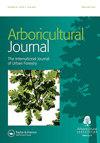2010 - 2018年托贝林冠覆盖和土地利用变化
Q3 Agricultural and Biological Sciences
引用次数: 1
摘要
通过分析树冠覆盖度来评估城市森林和土地利用是现代城市林业的一个常见方面。然而,在英国,只有非常有限的研究评估了冠层覆盖随时间的变化。德文郡的托贝曾在2010年对其树冠覆盖率进行过评估。我们的研究进行了对点分析,以评估2010年至2018年间托贝的冠层覆盖变化。从我们的分析来看,托贝的冠层覆盖在这段时间内没有显著变化,而不透水土地覆盖显著增加,农业土地覆盖显著减少。建成土地利用的冠层盖度呈静态或下降趋势;林地和农田的冠层盖度略有增加。在此期间,最重要的土地利用转变是从城市边缘的农业用途到住宅用途。托贝的树冠增长是由以前树木覆盖的增长驱动的,而不是来自新树木的种植,这引起了对该地区未来的担忧。这些发现强调了在开发新住宅区时,需要制定树木保护和城市森林规划的总体战略,以维持或增加树冠覆盖。本文章由计算机程序翻译,如有差异,请以英文原文为准。
Canopy cover and land-use change in Torbay from 2010 to 2018
ABSTRACT Assessing urban forests and land-use by analysing tree canopy cover is a common facet of modern urban forestry. In the UK, however, there are only a very limited number of studies that have assessed canopy cover changes over time. Torbay in Devon was previously assessed for its canopy cover in 2010. Our study carried out a paired-point analysis to assess the canopy cover changes across Torbay that had occurred between 2010 and 2018. From our analysis, canopy cover in Torbay did not significantly change over this time period, whereas there was a significant increase in impervious land-cover and a significant decrease in agricultural land cover. Built land-uses exhibited static or declining canopy cover; woodland and agricultural land saw slightly increased canopy cover. The most substantial land-use transition over this period was from agricultural to residential usage at the peri-urban fringe. Canopy gains in Torbay were driven by the growth of previous tree cover rather than from new tree planting, which gives rise to concern for the future of this district. These findings highlight the need for an overall strategy of tree protection and urban forest planning to maintain or enhance canopy cover when new residential areas are being developed.
求助全文
通过发布文献求助,成功后即可免费获取论文全文。
去求助
来源期刊

Arboricultural Journal
Agricultural and Biological Sciences-Agronomy and Crop Science
CiteScore
2.40
自引率
0.00%
发文量
28
期刊介绍:
The Arboricultural Journal is published and issued free to members* of the Arboricultural Association. It contains valuable technical, research and scientific information about all aspects of arboriculture.
 求助内容:
求助内容: 应助结果提醒方式:
应助结果提醒方式:


